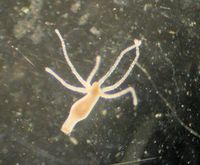Hydra (Hydra magnipapillata)
From The Aquarium Wiki
Hydra magnipapillata
4 Litres (1 US G.)
0.2-1.3cm (0.09-0.5 ")
Freshwater
6 - 8
22.2-28.9°C (72 -84 °F)
0-15 °d
1:1 M:F
unknown-unknowen years
[[]]
Family
Hydridae
Origin[edit]
- Rarely, if ever, found in stores, hydra species are nonetheless found almost globally in a variety of temperate and tropical freshwater habitats. Hydra in aquariums usually arrive as hitchhikers on plants.
Sexing[edit]
- Hydra species are not readily sexed, but as all species can reproduce asexually this is a moot point.
Tank compatibility[edit]
- Hydra species, like most Cnaridians, are carnivorous; they are infamous predators of eggs and small fry in spawning tanks, and of shrimplets in shrimp tanks. Conversely, certain fish, such as Blue Gouramies, will eat Hydra.
Environment specifics[edit]
- Hydra are highly adaptable and can survive in most freshwater tanks; their appearance and proliferation can frequently be traced to overfeeding the tank's primary occupants, especially with small live foods like baby brine shrimp or microworms. Green hydra species are photosynthetic and do better if light is present.
Notes[edit]
- Though they are not challenging aquarium inhabitants, Hydra species - the only freshwater cnaridians common in aquariums - are rarely kept for ornamental purposes; they are more often unwelcome hitchhikers, due to their propensity to hunt young fish and shrimp. Most aquarium keepers are more interested in eliminating them than keeping them as pets; medications that kill planaria are the most effective way to kill Hydras, as they are otherwise very resilient organisms that can withstand a variety of water conditions and breed rapidly in remotely optimal conditions.
